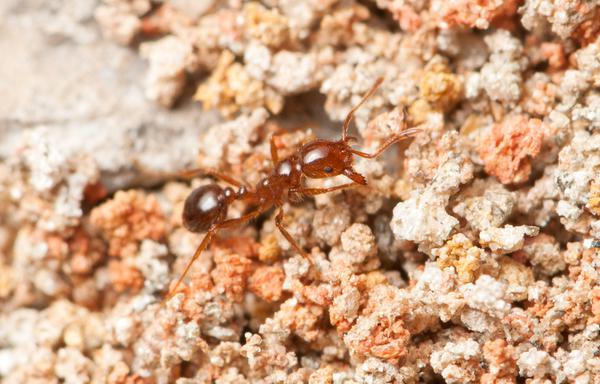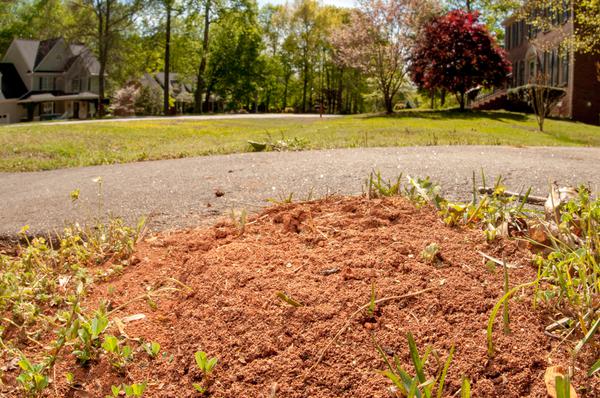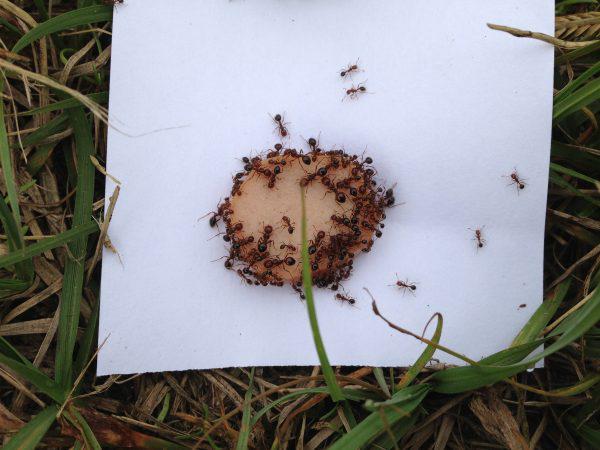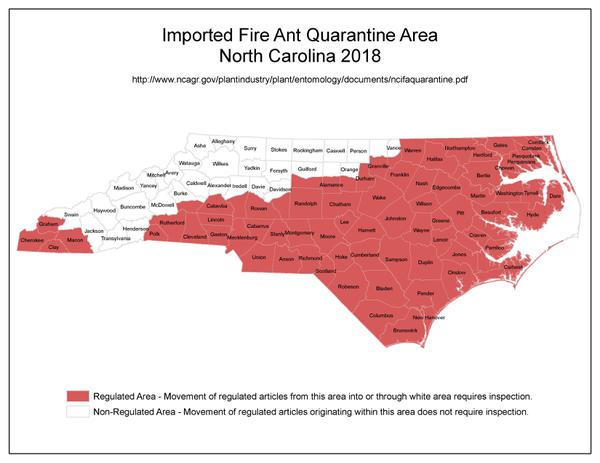Fire Ants in Commercial Turfgrass, Home Lawns and Landscapes
en Español / em Português
El inglés es el idioma de control de esta página. En la medida en que haya algún conflicto entre la traducción al inglés y la traducción, el inglés prevalece.
Al hacer clic en el enlace de traducción se activa un servicio de traducción gratuito para convertir la página al español. Al igual que con cualquier traducción por Internet, la conversión no es sensible al contexto y puede que no traduzca el texto en su significado original. NC State Extension no garantiza la exactitud del texto traducido. Por favor, tenga en cuenta que algunas aplicaciones y/o servicios pueden no funcionar como se espera cuando se traducen.
Português
Inglês é o idioma de controle desta página. Na medida que haja algum conflito entre o texto original em Inglês e a tradução, o Inglês prevalece.
Ao clicar no link de tradução, um serviço gratuito de tradução será ativado para converter a página para o Português. Como em qualquer tradução pela internet, a conversão não é sensivel ao contexto e pode não ocorrer a tradução para o significado orginal. O serviço de Extensão da Carolina do Norte (NC State Extension) não garante a exatidão do texto traduzido. Por favor, observe que algumas funções ou serviços podem não funcionar como esperado após a tradução.
English
English is the controlling language of this page. To the extent there is any conflict between the English text and the translation, English controls.
Clicking on the translation link activates a free translation service to convert the page to Spanish. As with any Internet translation, the conversion is not context-sensitive and may not translate the text to its original meaning. NC State Extension does not guarantee the accuracy of the translated text. Please note that some applications and/or services may not function as expected when translated.
Collapse ▲Description
Red imported fire ants, Solenopsis invicta, workers (Figure 1) are approximately ¼ in long, red-brown with shiny, dark abdomens. Fire ants are our only ants that have two bumps between the thorax and abdomen.
Pest Status
Fire ants in established turfgrass are considered serious nuisance pests due to formed mounds (Figure 2) interfering with ball play on golf courses, damaging equipment and are unsightly in home lawns. Additionally, when encountered by humans, pets, livestock and other animals, their stings can cause serious pain and injury.
Biology
Fire ant colonies consist of three adult types: winged males, reproductive (females) and worker ants. Winged males and reproductive start to fly when temperatures are between 70-95°F (spring and fall) and mate in flight. Winged males die shortly after and successfully mated females will search for a place to establish a new colony, shed their wings and start digging chambers in the soil for their eggs. New queens lay between 12-25 eggs that hatch within 7-10 days- established queens can lay as many as 800 eggs per day. Larvae hatch from the eggs and develop for 7-10 days before pupating. Adults emerge in about two weeks. Worker ants are wingless, sterile females that protect the colony by feeding the queen, defending the nest, foraging for food and caring for the brood.
Damage
With small colonies, nests can often go undetected until after heavy rainfall when fire ants build up mounds to escape the accumulating groundwater. As the population grows, they continue to produce mounds, particularly in sunny areas or next to sidewalks (Figure 3), driveways and other areas where soil temperatures tend to be higher.
Control
Cultural Control
Research at Texas A&M University suggests that drenching mounds with a large volume (>2 gal) of hot water (>90°F) or severe mechanical disruption can significantly reduce fire ant activity, however, satellite mounds can form within a few feet of the original mound within a few days. These methods can have useful, but temporary impact on fire ant colonies in areas where a chemical application is not possible.
Home remedies such as applying instant grits, molasses, aspartame or club soda to ant mounds do not work. Pouring chlorine, ammonia, gasoline or diesel fuel on mounds can contaminate the soil and groundwater and is dangerous.
Biological Control
There are a number of beneficial organisms in the turfgrass environment that can have an impact on fire ant populations if environmental conditions are conducive. Microorganisms such as microsporidia can infect immature and adult fire ants, causing shorter life spans and, ultimately, colony decline over several months. The insect-parasitic fungus Beauveria bassiana, toxic to white grubs and chinch bugs, produces spores that attach to ant exoskeleton, germinate and grow inside and outside the ant. However, B. bassiana is much more effective when it comes in direct contact with individual ants rather than applied to the soil surface.
Phorid flies are small, hump-backed flies that can parasitize adult fire ants. Adult flies hover above ant mounds, waiting to come in contact with a foraging worker ant. Once this occurs, females will lay an egg in the ant behind the head. When the egg hatches, the larva feeds inside the ant for approximately three weeks before the ant’s head detaches from its body and dies. Although phorid flies only decrease the colony population by less than 3%, fire ant workers escape to the underground when phorid flies are detected and are less likely to forage and build mounds.
Chemical Control
Chemical applications are most effective when fire ants become active in late spring and early fall when air temperatures are between 70-95°F. Make sure to confirm fire ants are actively foraging prior to application by placing a potato chip or a slice of hot dog (Figure 4) on the turf surface near the mound and allow it to sit for 5-10 minutes. There are two basic approaches to chemical control of fire ants. An insecticide can be applied to individual mounds (drench, bait) or it can be broadcast (granules, bait) over a larger area infested with fire ant colonies. Regardless of the method used, the objective is to kill not only the workers but also the queen, because she is the only ant in the colony that is capable of laying eggs.
Individual Mound Treatment: Individual mound treatments typically use less insecticide and are therefore less likely to have an impact on beneficial insects. Because you are treating each mound separately, it is often more time-consuming compared to placing bait stations or using a broadcast application. Be aware that when you treat individual mounds, it is possible that satellite mounds may appear within a few days around the original mound.
- Soil Drench
- Fast-acting, best applied in high traffic areas or turfgrass stands where there is a low tolerance for fire ant activity.
- Must apply with considerable volume (2 gal water/mound) of liquid to reach the queen in the nest or the colony will survive.
- Best to treat in mid-morning when ants are closest to the surface.
- Do not physically disturb the mound before or after application.
- Powder/Granules
- Apply powder/granules to top of the mound, follow with irrigation.
- Significant post-application irrigation required for active ingredient to reach the queen.
- Baits
- Slow-acting compared to mound drenches. Depending on active ingredient, products work in about 3-14 days.
- Do not place on top of mound. Foraging ants exit the nest along the outside base of the mound. Place product within a 2 ft radius around mound.
- Baits function as attractants to fire ants, so the product must be fresh (1-3 month shelf life). Keep the product dry (no rainfall, do not apply to wet grass) and do not store near products where it will absorb odors.
- Some products are not labeled for edible plants so make sure to read the label before placing near home vegetable gardens.
Broadcast Application: Broadcast treatments can either be applied as a contact insecticide (granule or liquid) or as a broadcast bait.
- Broadcast granules/liquid
- Granules applied to landscape in spreader and watered-in or as a spray application.
- Can choose between slow-acting/long-lasting (fipronil) with only one treatment permitted a year or a fast-acting contact insecticide (pyrethroid). Fast-acting insecticides typically only control ants on the surface but does not eliminate colonies nesting deeper in the soil.
- Bait
- Baits function as attractants to fire ants, so the product must be fresh. Keep the product dry (no rainfall for 24 hours following application, do not apply to wet grass) and do not store near products where it will absorb odors.
- Products that combine fast and slow-acting ingredients (Extinguish Plus®, Amdro® Firestrike) may work better because they provide quick fire ant suppression but have a longer duration of control.
Regardless of method or product, always follow the label directions when applying any fire ant insecticide. Some products are not approved for use in home lawns (see Precautions and Remarks section in chart).
| Insecticide and Formulation | Amount per 1000 sq ft | Precautions and Remarks |
|---|---|---|
|
acephate1
(Lesco-Fate)
(Orthene, T, T&O) 75 S
|
See label
1 to 2 tsp/mound
|
Distribute uniformly over mound. For best results apply in early morning or late afternoon.
|
|
avermectin/B1 (Affirm) 0.011% bait
|
5 to 7 tbsp/ mound
|
Distribute uniformly 5 to 7 level tablespoons of bait 3 to 4 feet around base of each mound.
|
|
bifenthrin1 (Menace, Talstar, others) F; G form also available
|
—
|
Follow label directions.
|
|
chlorpyrifos1 (Dursban) 4 E
|
See label
|
Not for use in home lawns.
|
|
clothianidin + bifenthrin (Aloft)
GC SC
LC SC
GC G
LC G
|
See label
0.27 to 0.44 fl oz
0.27 to 0.54 fl oz
1.8 to 3.6 lb
1.8 to 3.6 lb
|
|
|
deltamethrin (Deltagard) G
|
2 to 3 lb
|
Not for use in home lawns.
|
|
fenoxycarb (Award) 1 B
|
1 to 3 level tbsp
1 to 1.5 lb/acre
|
Single mound treatment. Not for use in home lawns
Apply uniformly with ground equipment.
|
|
fipronil (Topchoice, Fipronil, others) 0.0143
|
2 lb
|
Apply as a broadcast.
|
|
fipronil + bifenthrin + lamda-cyhalothrin (Taurus Trio G)
|
2 lb
|
Apply as a broadcast. Irrigate prior to treatment.
|
|
hydramethylnon1
(Amdro) 0.88% bait
(Maxforce G)
|
—
See label
|
Uniformly broadcast 1 to 1.5 pound of bait per acre with ground equipment on pastures, range grasses, lawns, and nonagricultural lands. Or distribute uniformly 5 level tablespoons of bait 3 to 4 feet around base of each mound. Do not exceed 1.5 pounds per acre.
|
|
imidacloprid + bifenthrin (Allectus, Atera)
|
See label
|
Rate varies with pest. Different formulations for different sites. Not for use in home lawns.
|
|
indoxacarb (Advion) bait
|
1.5 lb/acre
|
Bait formulation.
|
|
lambda-cyhalothrin1 (Battle, Scimitar, Cyonara)
|
See label
|
|
|
metaflumizone (Siesta) bait
|
1.0 to 1.5 lbs/acre
2 to 4 tbsp/mound
|
Do not exceed 4 applications in a one-year period.
|
|
methoprene (Extinguish) 0.5 % bait
|
1.5 lb/acre
|
Mound or broadcast.
|
|
methoprene + hydromethylnon (Extinguish Plus)
|
1.5 lb/acre
|
|
|
pyriproxyfen (Distance Fire Ant Bait)
|
See label
|
Mound or broadcast.
|
|
spinosad (Justice bait)
|
See label
|
|
|
spinosad A + D (Conserve SC)
|
0.1 fl oz/gal/mound
|
Dilute 0.1 fluid ounce in 1 gallon water. Use 1-2 gallons per mound.
|
1 Several tradenames available. Check label for active ingredient. Always follow label instructions.
Quarantine
Fire ants have a much greater impact on the ornamental plant, sod, and landscaping industries because of problems associated with shipping infested plant material into non-infested areas of the country (quarantine). The NCDA&CS Red Imported Fire Ant quarantine program restricts the movement of plant products from infested areas into non-infested areas (Figure 5).
Currently, three insecticides (broadcast application only) are approved for treatment of grass sod being shipped from quarantined areas:
- Bifenthrin: requires two applications one week apart with an exposure period of 28 days
- Chlorpyrifos: one application with an exposure period 2 days
- Fipronil: two applications one week apart with an exposure period 30 days
Depending on active ingredient used, the certification period will differ. Check the NCDA&CS website for additional information.
References
- 2017 Fire Ant Control Materials for Alabama Homeowners. Flanders, K. 2017 (revised). Alabama A&M & Auburn Universities Extension Publication ANR-0175-A.
- Common name: red imported fire ant, scientific name: Solenopsis invicta Buren (Insecta: Hymenoptera: Formicidae: Myrmicinae). Collins L. and R. H. Scheffrahn. 2016 (revision). Entomology & Nematology, FDACS/DP, EDIS. Publication Number: EENY-195.
- Managing Imported Fire Ants in Urban Areas. Drees, B. M. et el. 2017. USDA NIFA Cooperative Extension.
- Red Imported Fire Ant in North Carolina, Biting and Stinging Pests. Waldvogel, M. and P. Alder. 2017. NC State Extension Publications.
- 2018 Pest Control for Professional Turfgrass Managers. Bowman, D. et al. 2017. NC State Extension Publication AG-408. 81 pp.
- Extension Plant Pathology Publications and Factsheets
- Horticultural Science Publications
- North Carolina Agricultural Chemicals Manual
For assistance with a specific problem, contact your local N.C. Cooperative Extension center







